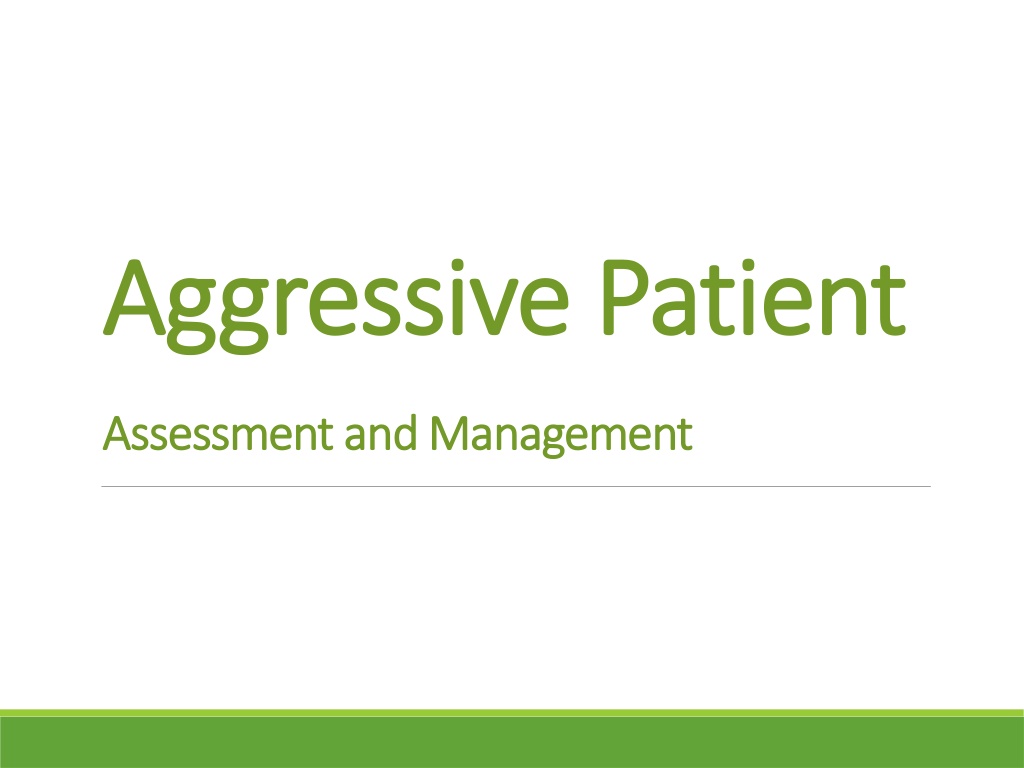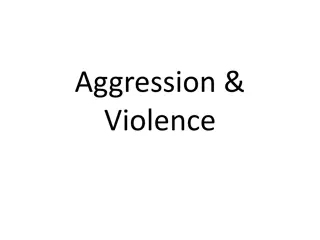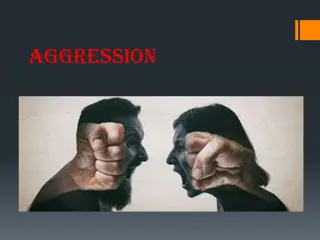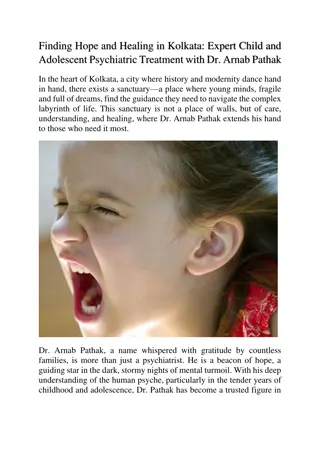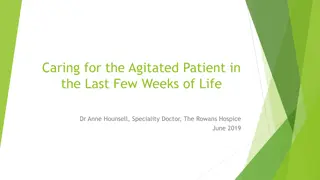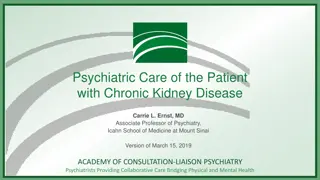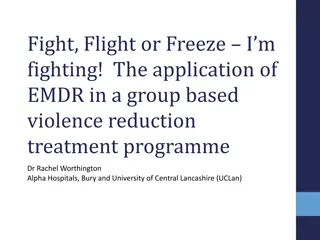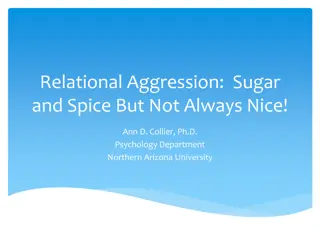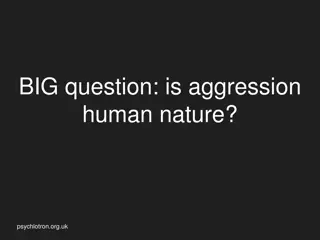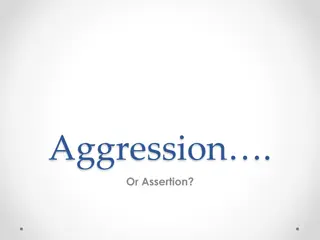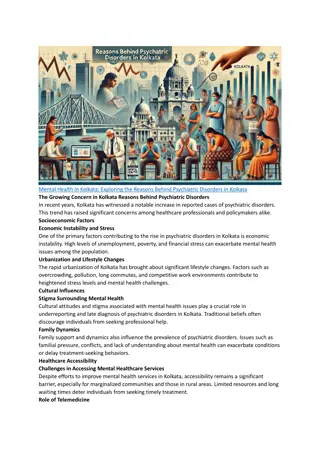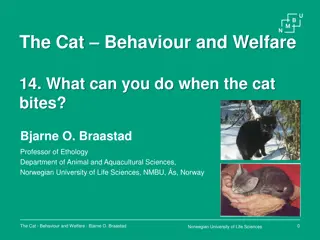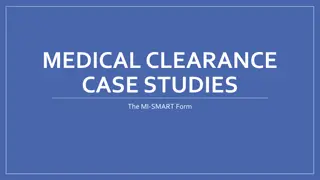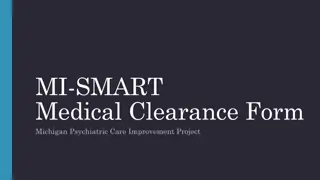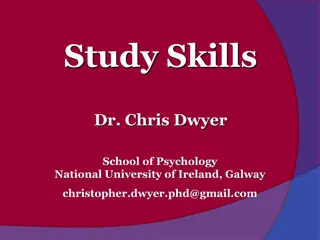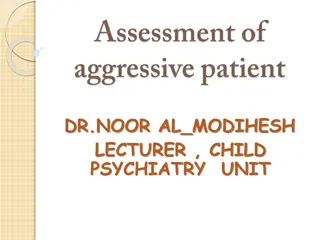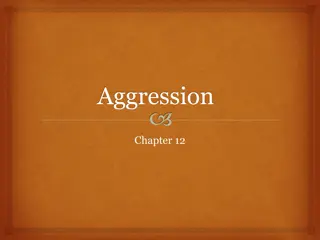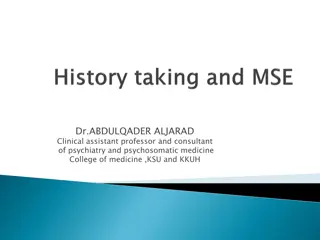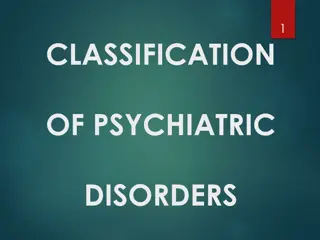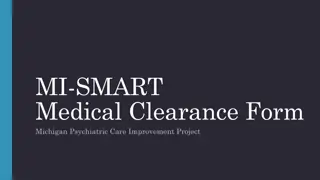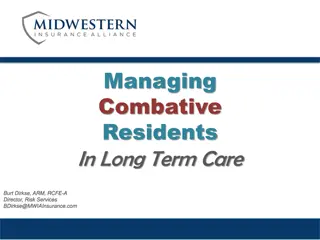Agitation and Aggression in Psychiatric Patients
Agitation is a tension state characterized by anxiety and hyperactivity seen in depression, schizophrenia, and mania, while aggression involves hostile thoughts or actions towards others, common in impulse control disorders. Psychiatric patients are usually not aggressive, but certain mental illnesses, physical diseases, and personality disorders can trigger aggressive behavior. Various examples of violent behavior in patients are highlighted, including those related to psychopathic personality disorder, schizophrenia, substance abuse, and specific medical conditions like dementia and epilepsy. Understanding the causes and manifestations of agitation and aggression is crucial in managing psychiatric patients effectively.
Download Presentation

Please find below an Image/Link to download the presentation.
The content on the website is provided AS IS for your information and personal use only. It may not be sold, licensed, or shared on other websites without obtaining consent from the author.If you encounter any issues during the download, it is possible that the publisher has removed the file from their server.
You are allowed to download the files provided on this website for personal or commercial use, subject to the condition that they are used lawfully. All files are the property of their respective owners.
The content on the website is provided AS IS for your information and personal use only. It may not be sold, licensed, or shared on other websites without obtaining consent from the author.
E N D
Presentation Transcript
Aggressive Patient Aggressive Patient Assessment and Management Assessment and Management
What is agitation: Tension state in which anxiety is manifested in psychomotor area with hyperactivity. Seen in depression, schizophrenia & mania. What is aggression: Hostile or angry feelings, thoughts or actions directed towards an object or person. Seen in impulsive disorders, impulse control disorders & mania.
Usually the majority of Psychiatric patients are not Hostile, Dangerous or aggressive, BUT occasionally Psychiatric Illness presented in Aggressive Behavior
Causes: Mental illness: Depression, Acute psychosis mania, schizophrenia Physical diseases : Delirium, dementia, epilepsy, alcohol and drug intoxication, W.D. Personality Disorder: Borderline, antisocial
Examples of Violent Pts.:- 1. Psychopathic Personality Disorder. 2. Hypomania or mania >>> may be angry & hostile if they are obstructed 3. Schizophrenia >> due to Delusional beliefs or in response to auditory Hallucination.
Examples of violent Pts. 4. Alcohol & Drugs:- Alcohol >> reduce self-control>> aggression C.N.S. stimulants ( amphetamine ) >> over activity & over stimulation >>> Heroin addicts during Withdrawal phase.
Examples of violent Pts. 5. Acute Confusional State >> clouding of consciousness >>> diminished comprehension, anxiety, perplexity, delusion of persecution 6. Epilepsy:- in the post-epileptic confusional state.
Examples of violent Pts. 7. Dementia:- cerebral damage >>>> decreased control >> aggression Catastrophic Reaction:- when facing difficult tasks they become restless, disturbed, angry, aggressive, throw things & attack people
General strategy in evaluating the patient: Protect self Avoid confrontation Prevent harm to self or others & take precautions Never attempt to evaluate an armed patient. Assess the suicidal risk factors Assess the violent risk: ideas, wishes, intention, access to weapons, male, lower S.E. status, little social support, past history, substance abuse, psychosis.
Assessment of dangerousness (predictors & risk factors) : Past history of violence or aggression Verbal or physical threats ( statement of intent ) Formulation of specific plan Available means ( eg. Weapons ) Alcohol or drug intoxication Paranoid features in psychotic patient Brain disease ( eg. Dementia ) Male sex, young age , poor impulse control family history of aggression Recent stressors , poor social support
How to interview aggressive patient: Do not be close in closed room Sit near the door Have security guard nearby or in the room Sit limits (Look, I want to hear what s wrong and help fix it. Could you lower your voice please so I can think better? If patient seems too agitated terminate interview
De-escalate angry behavior Build an alliance Solve problems
How to manage agitated patient: Medication Haloperidol, Benzodiazepines Physical restraints (restraint technique) Rule out reaction to other medication, e.g. Cortisol , anticholinergic delirium. Examine for command hallucination or delusional (paranoid) to which patient is responding. Try to have an unobstructed access to the patient .
How to manage agitated patient: Treat such pt. with understanding & gentleness as possible. Adequate security. Raise of alarm. Availability of more staff. clear prevention policy to all. Remain calm, non-critical. Trust your feeling Hand cuffs
How to manage agitated patient: - Use minimum force with adequate numbers of staff. - Talk Pt. down. - Physical restrain. - Medication:- * typical :- Major Tranquilizer . Chlorpromazine 50-100 mg im . Haloperidol 5 -10 mg im with ? Anticholinergic Rx. (eg . Procyclidine) or iv. . Clopixol Aquaphase 50-100mg im * atypical: - Risperidone 4mg or - Olanzapine 10mg im.
How to manage agitated patient: Medication cont.:- Benzodiazepines:- Lorazepam 1-2 mg po or im Clonazepam 0.5-2 mg po Diazepam 5-10mg po or iv. In epilepsy, withdrawal of alcohol or barbiturates. (may disinhibit violence.)
